
31 minute read
Essay
from Terra Dispositions
Human intervention of the landscape and climate by damming, filling wetlands and over-extracting is resulting in the rapid perversion of water bodies through the desertification or flooding of terrain and the ensuing contamination of reservoirs. In turn, these changes are disrupting ecosystems, reshaping geological borders, and causing irreversible damage that pose threats to clean water supplies. Water embedded in the earth is a crucial source of both potable water and wet-earth materials for building. However, as the water content levels in these materials are altered, properties such as strength, elasticity and resistance fluctuate, altering their useful functions. As these changes occur deep within the lithosphere, over prolonged periods of time, much of this transformation is imperceptible, leaving an unawareness of the criticality of the issue. Further, a misplaced nostalgia for a “natural” pre-industrialized ecological state is distracting from productive solutions that critically consider the present environment.
This thesis seeks to investigate the behaviors of residual wet matter, a byproduct of hydrological transformations, in relation to the contamination of water bodies. Using clay (a form of wet matter) and slip-casting (a form of industrialized ceramic production) as a medium for testing and simulating the effects of de-hydration and re-hydration on material, the thesis attempts to reveal these changes through the form-making of a temporal ecological monument. Water is an existential theme. Sea-level rise, coastal city depletion, floods, contamination of drinking sources and scarcity has channeled the discourse of the modern built environment. Yet humans continue to exert agency through influence and intent over their surrounding hydrology, scarcely considering the ecological ramifications of their interventions. One explanation may be the misguided assumption that water supplies are ubiquitous and abundant. Massive municipal and private projects to source, restrain or store water increasingly disrupts existing hydrology in the process.
Advertisement
The city of Ahmedabad in North Gujarat, India boasting a population of 5.5 million, was founded on the banks of the Sabarmati River in the 15th century. The metropolis relies on an expansive dam-canal infrastructure that diverts water from a perennial river to the seasonal Sabarmati River. Groundwater is also extracted from giant municipal wells on the river, working in unison with tube wells that tap underground aquifers. Recently, a series of mega infrastructure projects have fundamentally altered the river’s ecology, disrupting its seasonality. One of the most ambitious – the Sabarmati Riverfront Development Project – which uses two large barrages to hold perennial water supplies – paved over the river’s floodplains with concrete. Projects such as these preside extreme agency over the natural environment, as Tanvi Jain writes: “such expansionist, extractive and homogenizing infrastructural
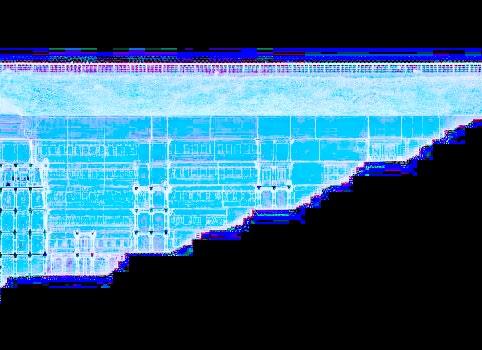
1.2 Partial elevation 3D scan visualization of Rani Ki Vav
growth to supply the city assumes water is ubiquitous and abundant – underscored by the hope for ‘limitless fresh water’ as a state-guaranteed civic right.” This region evolved several methods of fresh water harvesting, most notably the stepwell. These complex structures are ubiquitous in the historic landscape and worked in sync with seasonal rivers, streams, reservoirs and cisterns to sustain the surrounding cities. Stepwells performed functions beyond sourcing water, as they were deeply embedded in the region’s social, religious and ecological rhythms.
However, the 19th century brought the degradation of traditional water harvesting systems, reinforced by colonial policies such as land taxes, commodification and the dismantling of community agency over natural resources. In the early 20th century, the colonial state encouraged the use of mechanical pumps to expand industrialization. These technologies pumped out overwhelming amounts of water that didn’t allow for the natural seasonal replenishment of wells, causing many stepwells to dry out. The overexploitation of the hydrological landscape continued with large dam projects, the filling of lakes and paving over of watersheds. Today, only 3 of 17 documented stepwells in Ahmedabad still access groundwater¹.
As infrastructural projects require political action and intent for development, the ensuing water crisis is increasingly creating disparity and inequality around access to this vital resource. Geographers Eric Swyngedouw, Maria Kaika and Nik Heynen developed a discourse called Urban Political Ecology which claims that “specific forms of political economy metabolize the urban nature that adheres to new urban spaces and subjectives, while simultaneously unhinging, if not outright dismantling, the relations between existing urban subjects and nature.”² This approach understands urbanization to be a political, economic, social, and ecological process, one that often results in highly uneven and inequitable landscapes. They raise early twentieth century Parisian street engineering as one such example of a systematic urban production of nature. Streets ensnared water, gas, trees, stone and sewage systems. These spaces were designed to circulate natural matter (water), “leisure-nature” (boulevards lined with trees) and “state-capitalist notions of nature. (the surrounding real-estate). Planners saw the street as a circulatory mechanism for nature - “everything to the sewers” - whereas French urban agitators saw it as - “under the street the beach” – implying the multi-faceted perceptions of this political ecology.³ Thus, as urbanization takes control over the natural territories it occupies, it begins to prioritize certain conditions.
1-Tanvi Jain, Stepwells of Ahmedabad: water-harvesting in semi-arid India (The Architectural Review, 2021). 2-David Gissen, APE: David Gissen in Design Ecologies: Essays on the Nature of Design (Princeton Architectural Press, 2010). 3-Ibid.
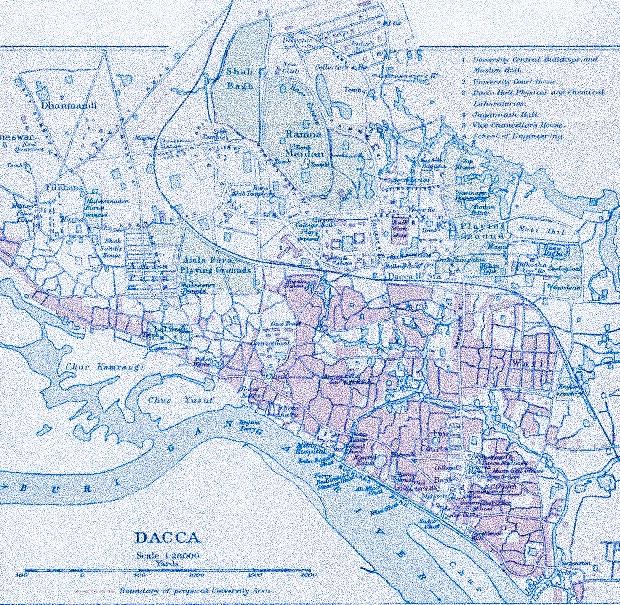
1.3 Dhaka in 1924 as a perpetually porous city, permeated and defined by water.
As further evidence of the human ignorance towards ecological consequences, it is notable that most water-based cities display a clear prejudice towards dry land. Bangladesh’s capital Dhaka, for example, emerged from the Bengal Delta. Due to furious landfilling operations, mostly due to real-estate ventures and infrastructural interventions, the landscape has become savaged. “Dhaka is symptomatic of most cities in powerful hydrological milieus and undergoing furious transformations where practices of planning, whether official, private or impromptu have succumbed to the regime of a dry ideology.” Chars, or land formations caused by the dynamics of soil-shifts and water flows, rise annually in the delta waters. They appear and disappear annually, while more stable ones become sites of settlement. The chars serve as registrations of earlier river turns and silt deposits. Further, “Dhaka and the delta appear as two separate entities, antithetical and strangers to each other. Fed on dry ideas, planners and policy-makers remain befuddled about envisioning or even managing a city in such a toiled terrain.” Most modern urban planning has therefore become an effort to “construct land,” – or to “manufacture dryness.” Landfills, embankments, bridges and roadways continue to support the technology of a dry culture.⁴
Even as rapid urbanization depletes its occupied territories, there is evidence to suggest that there is increasing awareness of the current hydrological situation in most regions of the world. Most notably, the capitalistic approach towards the commodification of resources including water suggests there is an awareness of the precarity of water availability and an effort to “insure it.” David Gissen, Professor of Architecture and Urban History at the Parsons School of Design, describes a capitalist world with a “rapidly expanding economy that transformed nature into a resource, urban space into investments and ideas into consumerist spectacle.”⁵
It seems then, that the response to the condition of precarity, humanity is quick to ensure the precarious. In doing so, there is an inherent alienation. Anthropologist Anna Tsing suggests that the entanglement of the human race with capitalism has alienated humans and other beings into resources. She points out that these systems have segregated humans and policed identities, obscuring collaborative survival: “we imagine precarity to be the exception in the world, but it is suggested that precarity is the condition of our time. Precarity is the condition of being vulnerable to others, as unpredictable encounters transform us; we are not in control, even of ourselves, we are thrown into shifting assemblages, which remake us as well as our others.
4-Kazi Khaleed Ashraf, Wet narratives: architecture must recognize that the future is fluid (The Architectural Review, 2017). 5-David Gissen, Introduction in Territory: Architecture Beyond Environment (Wiley, 2010).

1.4 Water as a traded commodity
Everything is in flux, including our ability to survive.”⁶ In Autumn Aroma, Tsing explains that humanity must now focus on exploring indeterminacy and the conditions of precarity, that is, life without the promise of stability. These new conditions must address the imaginative challenge of living without the “handrails” which once made us think we knew, collectively, where we were going.⁷
This precarity has, among other things, created a demand for the insurance of natural resources. As countries and regions around the world are experiencing droughts and ensuing water crises, starting in 2020 this vital resource was first traded on the stock market. The introduction of trading water futures has been described a sort of “risk management” of water. The regulated exchange now assigns a price to water, based on regional availability.⁸
An article from the ERB Institute at the University of Michigan similarly relates the concerns around water scarcity to the expansion of industries around water commodification, ranging from desalination to dam construction to bottling water. There is clearly an increase to privatize and sell water.⁹ In regards to this type of commodification of vital resources, Tsing writes: “There is one connection between economy and environment that seems important to introduce up front: the history of the human concentration of wealth through making both humans and nonhumans into resources for investment. This history has inspired investors to imbue both people and things with alienation, that is, the ability to stand alone, as if the entanglements of living did not matter. Through alienation, people and things become mobile assets: they can be removed from their life worlds in distance-defying transport to be exchanged with other assets from other life worlds, elsewhere. Alienation obviates living-space entanglement.”¹⁰ Even as the market trades water futures, these forms of ensuring the security of natural resources remains mostly inaccessible to those most affected by the rapid degradation of the environment, and most at risk to water scarcity. Therefore, as many of the entities that are initiating the very same interventions causing water scarcity to continue to commodify nature, there continues to exist an overwhelming ignorance towards the rapid deterioration of hydrological bodies in cities most reliant on them.
6-Anna Lowenhaupt Tsing, Arts of Noticing in The Mushroom at the End of the World (Princeton University Press, 2015). 7-Anna Lowenhaupt Tsing, Autumn Aroma in The Mushroom at the End of the World (Princeton University Press, 2015). 8-California Water Futures Begin Trading Amid Fear of Scarcity (Bloomberg, 2020). 9-Allison Torress Burtka and Wren Montgomery, A right to water (ERB Institute, 2018). 10-Anna Lowenhaupt Tsing, Autumn Aroma in The Mushroom at the End of the World (Princeton University Press, 2015).

1.5 View of the Los Angeles River
The general unawareness of shifting conditions is further induced by the existence of a misplaced nostalgia for a “natural” pre-industrialized ecological state, which distracts from productive solutions that critically engage the current environment. Humans are naturally nostalgic, sinking into comforting collective memories. Yet these same memories are often distorted by external stimuli and current phenomena, which can influence or completely alter them.
One explanation for the existence of this misplaced nostalgia around ecology may be the overly optimistic portrayal of human progress through the lens of the industrial revolution. This period marked a transition from hand production methods to machines, new chemical manufacturing and the increased use of steam and water power. However, this narrow lens of the celebration of progress often fails to consider the countless ecological consequences it produced.
In Arts of Noticing, Anna Tsing suggests that the industrial transformation was a bubble of promise followed by lost livelihoods and damaged landscapes: “if we end the story with decay, we abandon all hope - or turn our attention to other sites of promise and ruin, promise and ruin… we are stuck with the problem of living despite economic and ecological ruination. Neither tales of progress nor of ruin tell us how to think about collaborative survival.”¹¹ This narrative of ruination has become increasingly prominent in modern urbanization surrounding water bodies. Recently, the tendency is to respond to this ecological ruination by “reversing” the human imposed interventions. This suggests that another reason for the prominence of the misplaced nostalgia surrounding the environment is the general misunderstanding of what pre-industrial fluid ecologies were like, as argued by landscape architect and urban designer, David Fletcher in Flood Control Freakology. His description of the Los Angeles River as a fully engineered flood-control system is an example of a “freakish ecology,” no longer a natural, aqueous phenomenon, but a man-made web of vascular networks, many of which channel other flows besides water: freeways, streets, railways, power lines, cell towers, as well as sewage infrastructures. Embedded within the fabric of the watershed are political structures and bureaucracies, environmental conditions, economic organizations and cultural relations.¹² As a result of the vast interventions and systematic hydrological re-configurations, the river has ceased to exist as a single entity, rather it is a jurisdictional matrix of boundaries, rights-ofway, easements and liabilities: a zone comprised of an invisible pattern of ownership and maintenance jurisdictions, railroad lands and utility easements where federal, state, county, city and private territories overlap.
11-Anna Lowenhaupt Tsing, Arts of Noticing in The Mushroom at the End of the World (Princeton University Press, 2015). 12-David Fletcher, Flood Control Freakology (Actar, 2008).
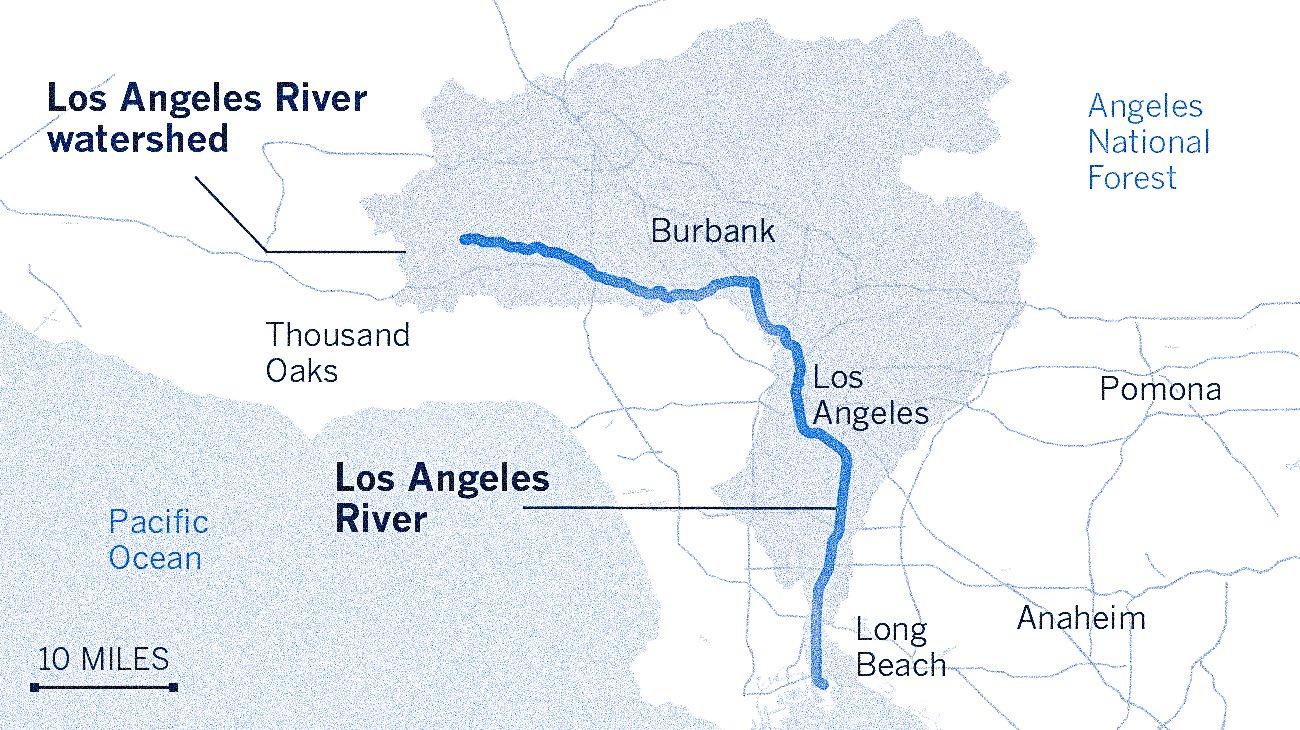
1.6 The Los Angeles River and watershed
These interventions may give the impression that the river isn’t even a river at all anymore. Fletcher counters this perception, claiming that the river did not exist in the summers in the unurbanized past, due to its flow being seasonal. This makes it more of a river now than ever before due to its continuous flow after human intervention. These transformations have been significant to the river’s ecology as well, introducing new vegetation and organisms. “The present river ecology is a churning soup of exotic and native vegetative communities that have been introduced since the nineteenth century, some by design, others by accident… colonizing the river’s naturalized reaches.” He notes that these new invasive species and biomass are constantly introduced to the river through wind and storm drains: “the infrastructural ecologies are systems in uneasy equilibrium.
The naïve desire to return the river to a “natural” state amidst an asphalt metropolis is, in fact, a threat to the urban ecologies that have emerged in response to the river’s modifications. Many of these infrastructural freakologies serve as green infrastructures, cleansing and processing excess nutrients, controlling erosion, and providing habitats which survives independent of human agency.”¹³ The transformation of this river is evidence of the need to move forward with the consequences of human intervention instead of attempting to “restart” and repair it. The reasoning for the recent tendency towards these processes likely lie in the increase of conservationist movements. However, this tendency is naïve, as modern nature and technology contain an inseparable web-work of human agency.
Gissen suggests that rather than using architectural technology to return nature to an impossible, pre-human, pristine state, we might consider fully employing the power of the architectural to uncover and produce new forms of nature. These new forms might offer a more socially complex and challenging image of nature forcing us to reconsider how the nature produced in buildings limits or furthers our social desires.¹⁴
Thus, instead of rescinding and repairing human intervention, it is imperative that humanity examines its impacts on the environment and how it impacts humanity. However, to best understand how these changes will affect humanity into the future, it is important to consider the relationships humans hold with ecology, ruination and the perception of progress. Historically, humanity has fetishized nature, which has also contributed to the misplaced ecological nostalgia. Menageries, private collections of wild animals kept indoors by the aristocracy in the 1900s, are re-emerging across design, for example. Like a living cabinet of curiosities, the exhibition was from one’s travels.
13-Ibid. 14-David Gissen, APE: David Gissen in Design Ecologies: Essays on the Nature of Design (Princeton Architectural Press, 2010).
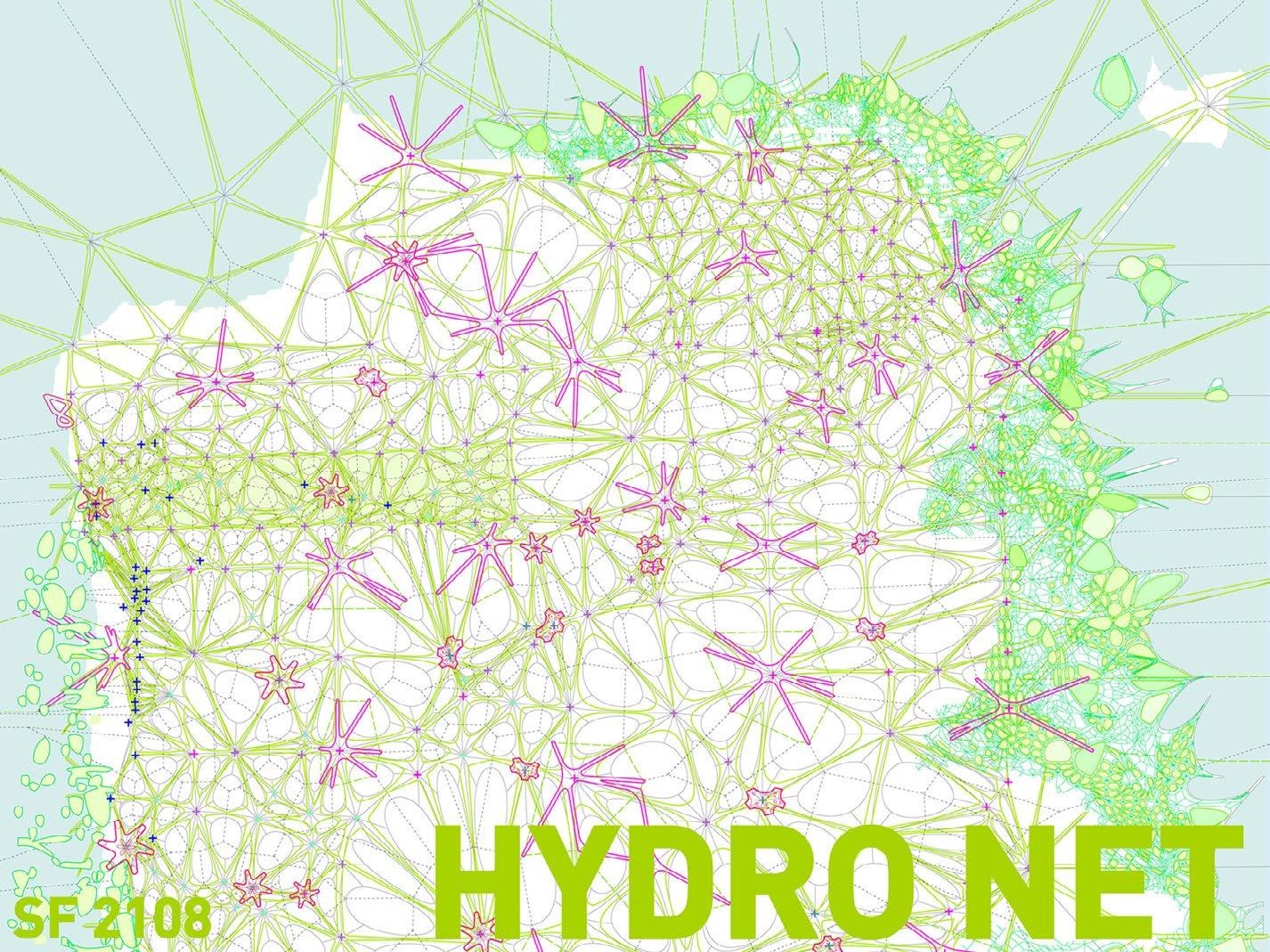
1.7 IwamotoScott’s Hydro Net, created for a 2008 competition to re-envision San Francisco
Changes in the climate are likewise driving people to bring nature indoors once more, to fetishize it under glass.¹⁵
Although there is a prevailing longing to return to pre-industrialized “nature,” it is worth considering that the “natural” versus “man-made” argument may be a false dichotomy altogether. Such dichotomies draw a distinction between two opposite notions, which leads to a strict “either/or” perspective, regarding them as mutually exclusive concepts. Yet it is suggested that many dichotomies, including the natural/un-natural are inherently false, as the two are synchronous. In Re-envisioning the Hydro Cycle, Rebecca Farnum, Ruth Macdougall and Charlie Thompson reference Castree’s suggestion of a society-environment nexus, or a networked series of connections, rather than a dichotomy, shaped by a dialectic synthesis between humans and their environment. Referring to Swyngedouw, who explores how “water and society make and remake each other over space and time” through a hydrosocial cycle, the authors point out that the flow of water is very much also saturated with “all manner of power relations.”¹⁶
Likewise, Gissen argues that at this point, all nature is produced, as there is no longer “natural” matter outside human reach or impact on Earth’s surface. No part has been left untouched, as all nature is laced with human agency and structure. He adds “because human beings can, at an instant, affect all nature anywhere on Earth, the decision to “leave nature be” can be considered a human production of nature.”¹⁷ This suggests that nature is a chiefly social production, emerging as a site of overcoding, where nature is attributed particular powers as different images of nature stand in conflict. This concept of assemblage suggests that nothing can be studied in isolation, as ecological and anthropological systems are all inherently interdependent.
Tsing further discusses how the varied species in an assemblage influence each other: some thwart each other, others work together to make life possible, others simply find themselves in the same place. It is critical to think through assemblage, as it urges the consideration of how gatherings sometimes become “happenings.” That is, greater than the sum of their parts. By studying patterns of assemblies in the world’s ecology, patterns of unintentional coordination emerge in these assemblages. Because they are interrelated to the needs and desires of humans, assemblages drag the political economy inside them.¹⁸
15-Sarah Rabia and Collyn Ahart Chipperfield, Imagination Building (Wiley, 2010). 16-Rebecca L. Farnum, Ruth Macdougall, Charlie Thompson, Re-envisioning the Hydro-Cycle 17-David Gissen, APE: David Gissen in Design Ecologies: Essays on the Nature of Design (Princeton Architectural Press, 2010). 18-Anna Lowenhaupt Tsing, Arts of Noticing in The Mushroom at the End of the World (Princeton University Press, 2015).
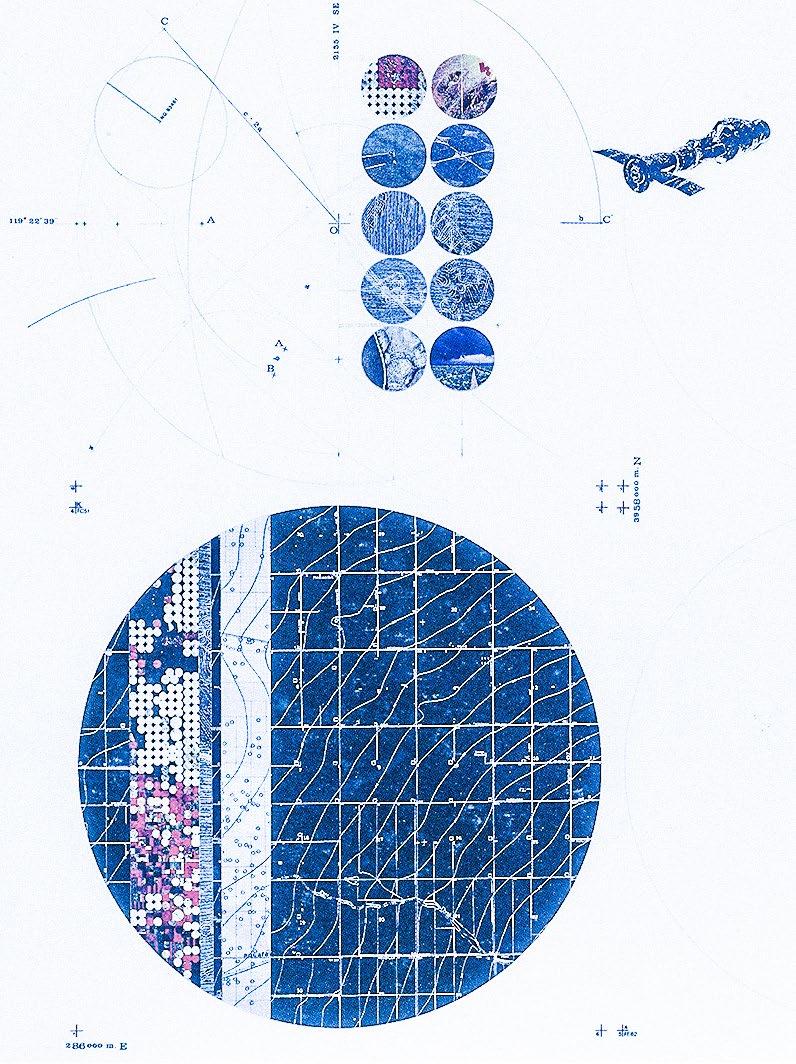
1.8 James Corner’s “Pivot Irrigators” diagram
As further evidence of this false dichotomy, landscape architect James Corner suggests that the very essence of architecture and territory is representative of humanity’s control over the environment, rendering them inseparable.
In Amphibious Territories, Corner examines the re-organization of terrain when it is cleared: “the deterritorialization of property suggests a condition where there is in fact no single power or authority but rather a mass collection of individual choices and actions…the ensuing result can be completely open and unregulated, thereby conflating questions of hierarchy, control and power.¹⁹ When examining the authorities of de-commissioned territory, it is critical to identify the residual substances and programs that are the product of the territory. In Landscraping, Corner references landscapes that are closed down, voided and left to nature. This is presented in the form of a cleared, de-commissioned terrain that is essentially empty of references, representations or programs. Corner therefore suggests that empty spaces are not simply left-over results of desertion but rather of construction: they are intentionally “set-up” and staged as open grounds for wholly indeterminate futures. Decommissioning and reallocating resources is an inevitable aspect of the urban economy.²⁰ This implies that territory never actually loses its coded meaning. Corner proposes instead of “scaping” the land into a formal composition of meaning and presence, it is much more prosperous to examine possibilities for “scraping” the land of its various residues: symbolic, political and material.
The scraped ground then becomes an empty field of absence that accommodates multiple interpretations and possibilities.²¹ As previously discussed, the understanding of territory as being inherently laced with human agency suggests an architect is simply re-coding or re-programming territory. In Territory: From the Biological to the Geological, architectural theorist Stan Allen suggests: “landform building is less interested in the imitation of natural form and more interested in new programmatic possibilities that are opened up by the creation of artificial terrains. Landform building favors program, process and affect over formal similarity. It can suggest a productive new approach to sustainability and enhanced environmental performance in which form – rather than technological fixes – can play an active role.
Landscape is no longer viewed as pure exteriority – as the nature or wilderness out there – but is understood as an immersive environment.²² If the site upon which these constructions appear is deeply encoded, then so are its materials and the matter that constitutes it.
19-James Corner, Landscraping in The Landscape Imagination (Princeton Architectural Press, 2014). 20-Ibid. 21-Ibid. 22-Stan Allen, Territory: From the Biological to the Geological
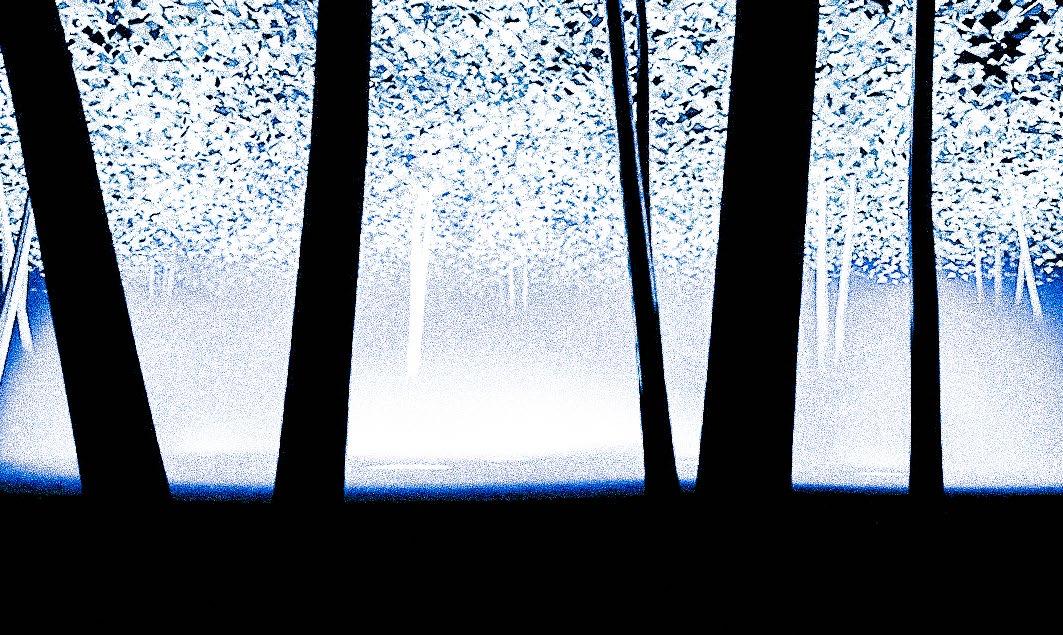
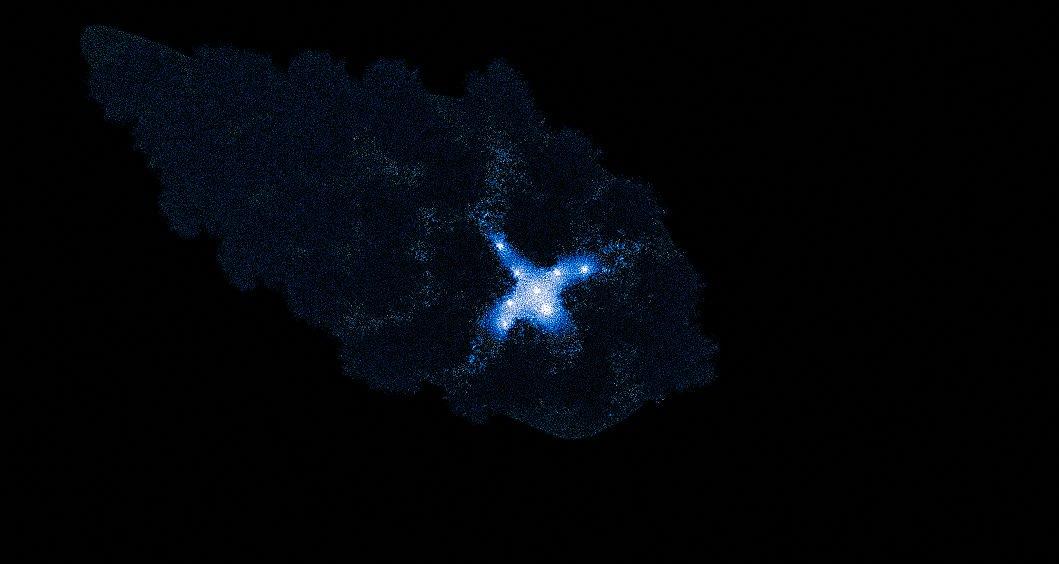
1.9 Philippe Rahm architect’s Second Summer temporal installation in Eybesfeld, Austria
Humanity has altered and manipulated the environment for millennia, re-programming it for agricultural production, dwellings and convenience. The prominence of these human transformations has led geologists to label the current geological age the Anthropocene, viewed as the period which human activity has been the dominant influence on the environment and its territories. Gissen similarly labels this production of human and animal environments as terraforming. He notes that buildings actively produce or wrap the socio-natural conditions around the architectural object. Architecture here becomes a material and theoretical ‘genesis device – a machine that makes environments but also ideas about nature and environments.’²³ Although all nature has become inherently laced by human agency as these theorists suggest, there remains a lack of representation and therefore general mis-understanding of the influence of human intervention on the environment. As such, the misplaced nostalgia of a pre-industrialized and human altered world, rooted in the mis-remembering of an environment absent of human actors continues to persist.
Although overarching unawareness and a nostalgic pull towards a false reality is symptomatic of the Anthropocene, this thesis argues that through critical interventions, notably in the form of “temporal monuments,” there can begin to be a catalyst for the procurement of an awareness of the ecological situation of our time. Monuments are erected for a variety of purposes, typically to commemorate a significant person or event. They exist in spaces as a marker of a series of ideas or histories related to the geographical location upon which they stand. In Territory, Architecture Beyond Environment, Gissen suggests that monuments emerge as complex territorial assemblages of natural and urban web-works. He states that monuments bring the routes, aesthetic ideas, rendered natural materials and investments into focus and into existence, just as these aspects represent a system that enables the monument’s construction. Monuments are designed to evoke specific emotions and reactions in the viewer. They can be integrated into the local context or exist as prominent outliers. The power in these monuments is their ability to enable a deeper understanding of the possible realities lurking in the world.²⁴
The “territories” which host monuments are equally significant, acting as the datum for their purpose. Gissen defines territory in this context as a produced (versus given) environment generated by a combination of architectural concepts and architectural and natural matter that is always in a state of its own realization.
23-David Gissen, Introduction in Territory: Architecture Beyond Environment (Wiley, 2010). 24-Ibid.
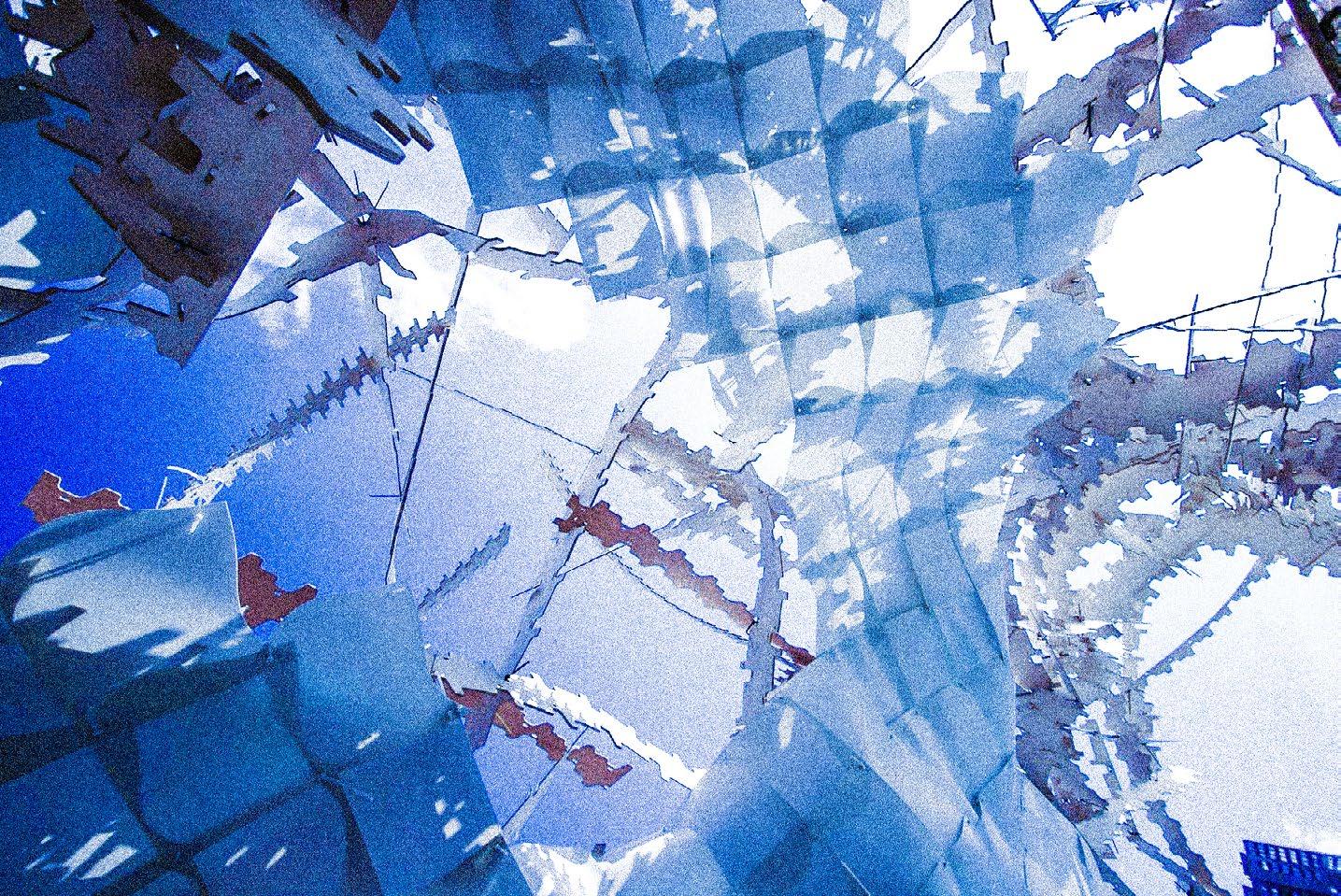
1.10 Situ Studio’s Solar Pavilion
The built environment is thus directly encoded by the territory it occupies. Gissen adds: “the structures assembled on these territories attempt to recode their surroundings… these assemblies are simultaneously autonomous and integrated in the landscape as artefacts in a territory. They serve to articulate an environment within the environment, as possible foreclosures between science, nature and art.”²⁵
Depending on the stakeholder, natural spaces can change in purpose and function. Thus, these spaces are coded in relation to the socio-political conditions in which they were produced. Gissen suggests that this type of political ecology might inspire historical work on architecture’s interaction with nature, going further as to examining the natures that move through the production of architectural and social history itself. He raises archives, historical reconstructions and museums as concepts and sites bursting with complex political ecologies of their own, as museums maintain very strict environmental guidelines to assist in acquisition, maintenance and the experience of historical artifacts. An architectural political ecology, may in turn, engage with some of the most troubling forms of nature produced by the very act of building.²⁶ By building in consideration of these residues, the design is better integrated and pragmatic in relation to its host territory. In Why Site Matters, Carol Burns and Andrea Kahn similarly argue that design does not simply impose on a place, as the site and designer engage in a dialogic interaction, where a site acquires design meaning only through its apprehension, intellectually and experientially. Therefore, they claim the site as a relational construct that acquires meaning and value through situational interaction and exchange. This relational condition of the site derives from uninterrupted exchange between the real and the representational; the extrinsic and the intrinsic, the world and the world-as-known.²⁷
It is also important to consider the significance of temporality in interventions. Temporality allows for iteration, and therefore optimization of the design to its respective environment or territory. In Out of Control: Experiments in Participation, Situ Studio describes their small-scale experiment of a temporary deployable structure of a solar pavilion which has allowed them to test hypotheses about local rules of assembly at an architectural scale. Their aim was to experiment with the output potentials of local digital fabrication and to create an open construction system that encourages participation and prohibits a repeatable configuration, with the goal to defer the aspect of indeterminacy to the actual on-site construction process, rather than within the design process.
25-Ibid. 26-David Gissen, APE: David Gissen in Design Ecologies: Essays on the Nature of Design (Princeton Architectural Press, 2010). 27-Carol Burns and Andrea Kahn, Why Site Matters in Site Matters (Routledge, 2020).
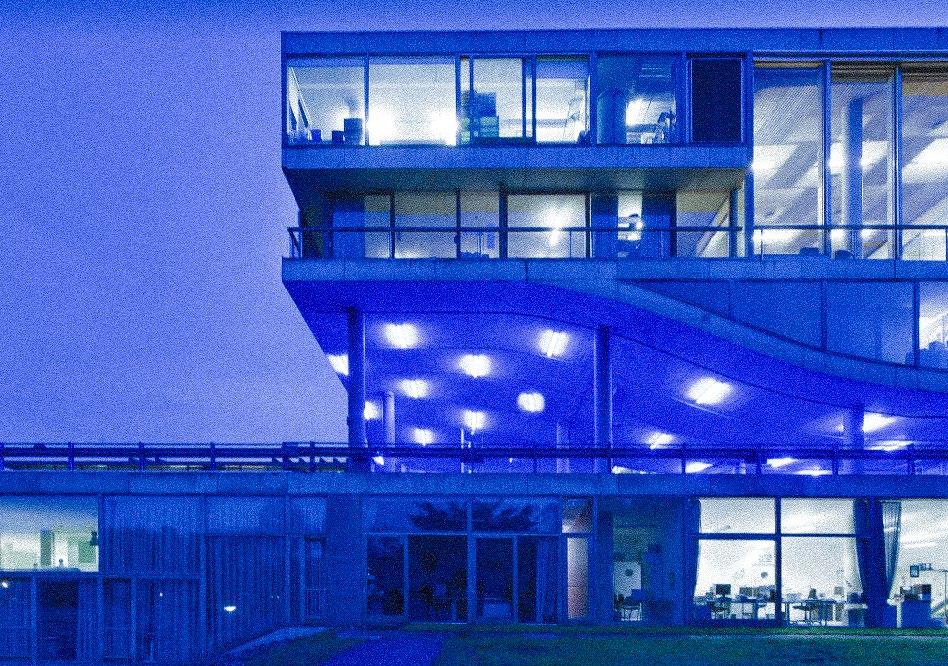
1.11 MVDRV’s Villa VPRO
A universal connection along components’ edges allowed for sufficient freedom to force indeterminacy and variability in each assembly event. They discovered that forces in the structure would take a few days to reconfigure themselves under slight changes in temperature and humidity. Only through full-scale testing they could gain an awareness of how the macro-characteristics of the whole depended upon the sequencing of construction and time-scale of its various micro adjustments. Over the life of the pavilion, notations were made to indicate certain configurations that worked especially well. The simplicity in the pavilion’s rules, and the fact that small quantities of customized components can be economically manufactured and assembled offers a hypothesis for new systems of decentralization in the construction of local environments. Thus, the aspect of participation is extended beyond the design stage into the fabrication and construction stages.²⁸
The dynamic nature of this intervention is further evidence of the effectiveness of temporal monuments, in terms of their connection to their respective territories and responsiveness to changing phenomena. Stan Allen in From the Biological to the Ecological suggests that buildings interact with, and adapt to, the worklife of its inhabitants. Using MVRDV’s Villa VPRO completed in 1997 as an example, he claims that the innovation of the project at the time was to claim the building is not something that occupies the site but rather that the activity of the architect is to construct the site. Landscape implies process and change, not form: it cannot be designed and controlled as a totality but instead must be projected into the future and allowed to grow in time.²⁹ Allen likewise suggests that in the past two decades, there has been a desire to make architecture more lifelike, more fluid, adaptable and responsive to change. These contemporary strategies suggest that the architect does not so much imitate the forms of nature as model the natural process of form generation. He explains that although this has produced compelling formal results, there are conceptual and procedural limits – a lot of these structures are static although their design generators are dynamic. “The forms generated may resemble nature, but they retain little of the performative or adaptive complexity of life itself.” He notes that despite advances in fabrication technology, a large gap still exists between the forms generated by the software and the intractability of materials.³⁰
28-Situ Studio, Out of Control: Experiments in Participation. 29-Stan Allen, Territory: From the Biological to the Geological. 30-Ibid.

1.12 Yusuke Obuchi’s Wave Garden is a prototype for a dual-function power plant and park
The short-comings of this digital to physical pipeline remain as major obstacles to the interpretation of form and design. Additionally, issues of representation can begin to determine the way territory and site are interpreted, as Corner suggests in Landscraping in The Landscape Imagination: “instruments of representation allow developments in the techniques of description.
Graphic tools inform how designers think. Thought is both allowed and constrained by formats (plans, sections, maps, photography, video), scale and scope, and informational frames of reference.” Temporal phenomena (such as hundred-year flood lines) or otherwise hidden factors, assimilates situational influences to the site to support relational understandings. Physical material contact delivers experience and perception. Direct material physical encounters with sights, sounds, smells and textures yields yet another body of site knowledge. Bracketed through subjective experiences of phenomena.³¹ Temporal monuments can therefore act as effective registrants of temporal phenomena, revealing change over time in a clear and compelling way. They adapt to the changing conditions and territories they inhabit, while simultaneously indexing the coded layers of agency and human influence that act upon them.
In contrast, there is also evidence to suggest that temporal monuments are ineffective interventions, as they can only exist as permanent structures or systems, which become deeply and fully embedded into their respective territories. Architectural assemblies for example, are often considered to be permanent structures, built to endure and persevere through changing conditions of weather, time and politics. In Amphibious Territories, architectural theorist Ila Berman elaborates on the architectural tradition that has been historically engendered by the values of firmness, stability and permanence. These modern infrastructural artefacts have promoted static, discrete and formal systems over mobile, continuous and material ones. Generally, not integrating the concept of fluid geography and the logics of continuous mutable ecologies into their development. “Operative traits of the real; continuous intrinsic to natural matter that reveal the forces responsible for its genesis. Deformation of an inhabitable artificial geography, challenges architecture to imagine itself as an open territory and dissipative device – a dynamic material mediator.”³²
When considering the purpose of a designer within the context of these ecological shifts, it is important to consider the tools architects deploy to shape the built environment.
31-Carol Burns and Andrea Kahn, Why Site Matters in Site Matters (Routledge, 2020). 32-Ila Berman, Amphibious Territories in Architectural Design Magazine (Wiley, 2010).
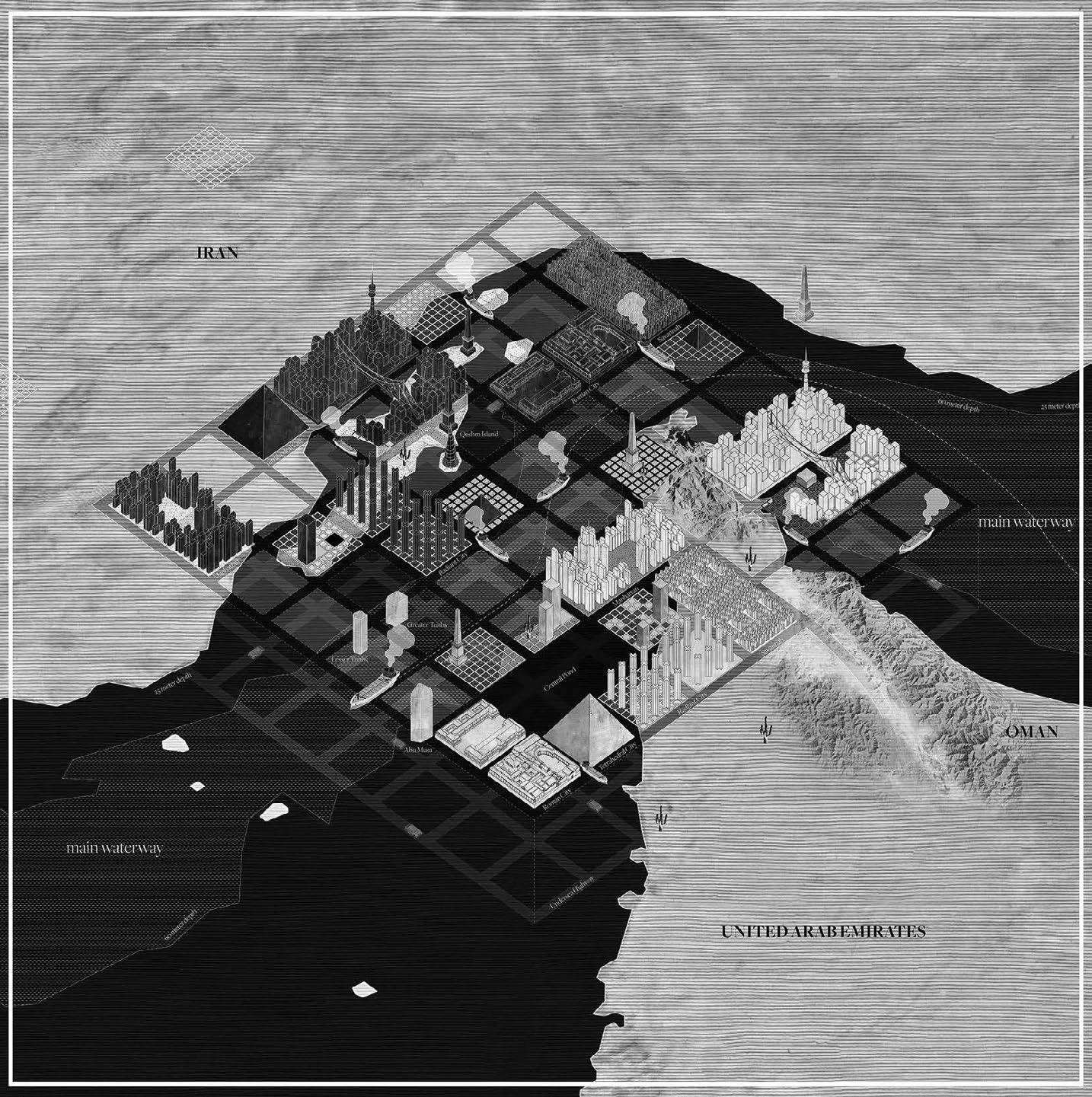
1.13 Strait of Hormuz Grand Chessboard: an anthropocene architecture
Stan Allen claims that “architecture is situated between the biological and the geological – slower than living beings but faster than the underlying geology. Resistance and change are both at work in the landscape: the hardness of the rock and the fluid adaptability of living things.” He continues stating that ecologies, unlike buildings, do not respect borders. Instead they range across territories and establish complex relations operating simultaneously at multiple scales.³³
When considering scale, it is notable to consider that the materials involved in the construction of monuments and their inherent limitations may also promote the permanence of the built environment. Wet-earth materials and alloys (clay, silt, concrete) are especially seen as unruly and complicated. Architects have long sought to control and harness the properties of this type of matter, however most existing material processes seek to control and contain material behavior.
In Matter Matters, artist and philosopher, Manuel DeLanda claims that physical information pervades the world and it is through its continuous production that matter may be said to express itself. He defines material expressivity through the notion that expression has gone beyond the production of information to include its active storage and processing: “matter expresses itself in many ways, from the simple emission of physical information to the deliberate use of melody and rhythm. The universe itself may be viewed as a grand symphony of material expressivity.”³⁴ Current representational methods are also limiting the way transformations are perceived, giving the misleading notion of permanence. In Environmental Visualization in the Anthropocene: Technologies, Aesthetics, Ethics, Carruth and Marzec explore ways that technologies and media of environmental imaging can be unruly and revelatory. They explain that visualizations can playfully and powerfully explore ideas of resilience, adaptation and synthetic ecologies in the Anthropocene. This alternative visual aesthetic needs attention in an age marked by ideologically conservative forces that seek to govern how communities around the globe visualize and imagine possible ecological futures.³⁵
There are also often gaps caused by representation. Architect John May considers this in The Becoming Energetic of Landscape: “there is a disjunction between automated observation and human representation. Landscape is not a primary or mutable datum upon which energy is organized; it does not exist beyond or prior to the geometrical organization of territories, or the residue
33-Stan Allen, Territory: From the Biological to the Geological 34-Manuel DeLanda, Matter Matters in Domas (Domas, 2005). 35-Alison Carruth and Robert Marzec, Environmental Visualization in the Anthropocene: Technologies, Aesthetics, Ethics (Duke University Press, 2014).

1.14 Perry Kulper’s Island Strategic Plot Drawing
of material life; it does not “contain” the detritus of social processes, nor is it a ‘construct’ of those processes. We must develop some understanding of the technologies and practices that treat the landscape as their principal object of inquiry. How are the facts of this conceptual object established, its truthfulness made evident? What discourses and instruments do we surround it with? How do we represent it, how do we visualize it?³⁶ It becomes evident then that permanence in regard to monument is a false perception, brought about by representational gaps and material limitations. Architect Perry Kulper elaborates on this in The Precision of Promiscuity by arguing that the mediums, techniques and design methods architects conjure are approximate and indirect or outright mischievous. He suggests that architects “pick the pockets of truth, acting like con artists, leveraging sleight of hand tactics.” He continues: “Architects work in all kinds of ways – 2d, 3d and temporally changed visualizations, models, objects and invented bits, in fact, never before has the range of techniques to drive design been so robust.”³⁷ As Kulper suggests, such Technological advancements are increasingly bridging these gaps and challenging traditional material manipulation. Augmented reality for example, in its process to overlay computer-generated information on to the real world and vice-versa, promises to truly blur fantasy and reality. BT visionary Ian Pearson believes AR will mean we can fashion the way we experience environments.³⁸ By utilizing technological advancements, acknowledging the notion of the misplaced nostalgia and by working through a critical lens, humanity can begin to move towards a more productive future ecology.
In Amphibious Territories, Ila Berman writes: “as the discreet architectural object is stretched to the scale of geographical, a new monumental nature is created – one that is highly articulated and deliberately defined, yet also fluid and material in its evolution, operation and effects. In turn, this should challenge us to incorporate soggy spaces of porosity, elasticity and growth within our static and solid waterproof environments, just as they also enable us to imagine new opportunities for amphibious infrastructures and architectures that attempt to synthesize technological artifice and its discrete acculturated systems with the fluid geographies and vital ecologies of a continuous material nature. Bays, rivers and wetlands adjacent to our urban centers, have remained conceptually and physically under engaged, except by those invested in infrastructures intended to control and restrain them.
36-John May, The Becoming-Energetic of Landscape in Landscapes of Energy: New Geographies (Harvard GSD, 2010). 37-Perry Kulper, The Precision of Promiscuity (Offramp, 2015). 38-Sarah Rabia and Collyn Ahart Chipperfield, Imagination Building (Wiley, 2010).
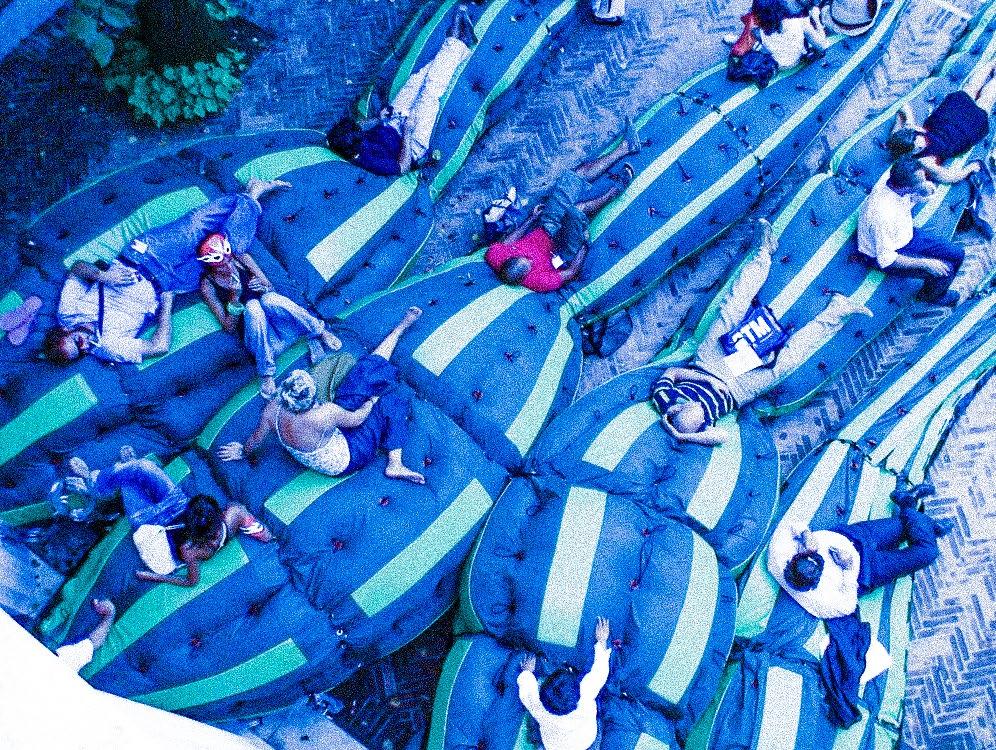
1.15 Anderson Anderson Architecture’s Alluvial Sponge Comb prototype at the 2006 Venice Biennale
The complexity and boundlessness of this liquid landscape has yet to be fully explored, for the dynamic potential it offers for amphibious urban life as well as its provision of a future territorial frontier for expanded architectural expansion.³⁹ Due to the human interventions that have reshaped the hydrological landscape, there is a need for architecture that better adapts to a more porous and engaged narrative with water. Working in unison, not against, water will be the most productive action to dismantle false perceptions of the pre-industrialized environment, and to procure awareness of the current ecological state.
39-Ila Berman, Amphibious Territories in Architectural Design Magazine (Wiley, 2010).





